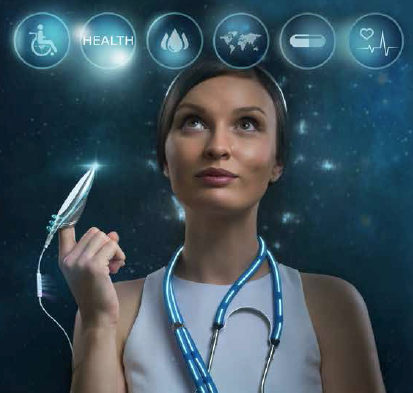 The coolest thing about wearable devices used for tracking biometric data is not what they are today, but what they will be in the future. Wearables, now used by about 20% of the population, are predicted to become as second nature to consumers as mobile phones, providing seamless and valuable information that can improve better health outcomes. Experts say uptake of wearable technology will increase rapidly in the next three to five years.
The coolest thing about wearable devices used for tracking biometric data is not what they are today, but what they will be in the future. Wearables, now used by about 20% of the population, are predicted to become as second nature to consumers as mobile phones, providing seamless and valuable information that can improve better health outcomes. Experts say uptake of wearable technology will increase rapidly in the next three to five years.
The Fitbits, Jawbones, and iWatches of today are just the beginning of a movement that could have incredible potential for all stakeholders in healthcare, including patients, physicians, and payers and provide an opportunity for life-sciences companies to participate in providing tools that benefit everyone.
In the early adoption phase now, most of these devices are being used by tech and fitness geeks and quantified “selfers." But remember how the mobile phone started? In 2000, there were barely 1 billion reported cellphone users. Today, Cisco reports that global mobile devices and connections were 7.4 billion in 2014. Mobile phones went from novel to ubiquitous.
A study by Kleiner Perkins Caufield and Byers found the average user checks his or her phone almost 150 times per day.
Our thought leaders envision a future world of wearables that will have the same ubiquity; consumers will track and upload data as automatically as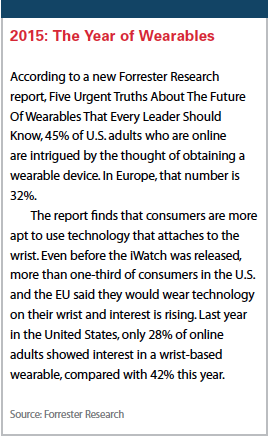 they check their cell phones. Healthcare information will be collected and communicated through frictionless systems, blurring the lines between health data tracking and daily living activities.
they check their cell phones. Healthcare information will be collected and communicated through frictionless systems, blurring the lines between health data tracking and daily living activities.
Wearables will become much more meaningful than counting steps. They will not only track activity but motivate and influence consumer behavior through feedback. They will be smart devices that not only collect data, but also use the data in a valuable way.
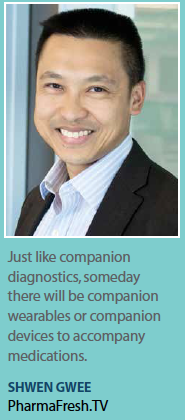 “Wearables are not just Fitbits," says Shwen Gwee, founder and host of PharmFresh.TV and Med 2.0. “They are evolving beyond what we wear on our wrists and seamlessly integrating items we already use."
“Wearables are not just Fitbits," says Shwen Gwee, founder and host of PharmFresh.TV and Med 2.0. “They are evolving beyond what we wear on our wrists and seamlessly integrating items we already use."
From shirts, socks, patches, adhesive strips, and implantables, wearables beyond the wristband are increasingly being explored.
For example, the biopharma company Intarcia Therapeutics is developing a matchstick-sized mini-pump for the treatment of type 2 diabetes. ITCA 650 is placed subdermally in the patient once or twice a year for the continual delivery of the diabetes treatment drug exenatide. The mechanism could become the world’s first and only injection-free GLP-1 agonist.
“Just like we have companion diagnostics, we will someday have companion wearables or companion devices to accompany medications," Mr. Gwee predicts.
West Pharmaceutical Services and HealthPrize Technologies are collaborating to link self-injectable drugs with electronically connected wearables to improve adherence.
The joint venture is capitalizing on the large number of smartphone users, and progress to date is attributable to wide mobile phone adoption, says Zach Marks, director, delivery systems marketing at West.
“If we had tried to do this project before 2010, we would have had to create a custom connected device, however, using industry standard smartphones has accelerated adoption throughout the healthcare field," he says.
The collaboration between West and HealthPrize creates a tracking mechanism that monitors when patients take their self-injected medication and  provides a reward system for being compliant with the prescribed treatment regimen. The combined platform works across any patient self-injection device, and also includes digital patient education, which is critical to adherence.
provides a reward system for being compliant with the prescribed treatment regimen. The combined platform works across any patient self-injection device, and also includes digital patient education, which is critical to adherence.
“Combining the capabilities of our two companies is a very powerful way to enhance the patient experience, and for patients with diabetes, for example, it can make adherence part of everyday life in a very positive way," says Dr. Katrina Firlik, chief medical officer and co-founder of HealthPrize.
What Wearables Mean for Pharma
Wearables such as these will present opportunities for pharma companies to increase adherence and bring value beyond the pill in today’s ACA environment.
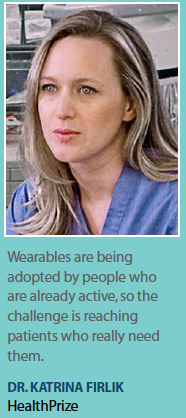 The industry is currently segmented into three levels of adoption; companies that are experimenting, companies that are waiting and watching, and companies that believe the trend will never get off the ground.
The industry is currently segmented into three levels of adoption; companies that are experimenting, companies that are waiting and watching, and companies that believe the trend will never get off the ground.
“Some biopharma companies are beginning to realize the potential ramifications to their business that wearables can bring, and they are starting to explore with pilots and new technologies," says Brian Williams, director at PwC. “Companies can use technology to facilitate the expansion or innovation of their business model to capture value beyond the episode of care. This is vitally important in the United States, as we migrate to an environment where reimbursement is based on outcomes."
To take advantage of these opportunities, pharma companies will most likely partner with both large and small technology developers, as these technology innovators are driving the trend for wearables.
“The opportunity for biopharma is that wearable devices allow them to develop a value-oriented business model," Mr. Williams says. “On the other hand, companies need to avoid the temptation to think that they are now technology companies. Rather, biopharma companies need to develop an innovation process that prioritizes business model innovation and one that fosters partnerships that provide access to devices and technology to support outcomes-based reimbursement models. A successful partnership will be a determinant of success."
Mr. Williams is referring to the fact that wearable innovation is coming from outside the industry, from large creators such as Apple and Google, and small incubators and start-up companies.
“There will be more partnerships with huge technology companies in the future," Mr. Gwee says.
He lists these heavy hitters as proof: AbbVie and Calico, Biogen and Google, Genentech and 23andMe, Novartis and Google, Novartis and 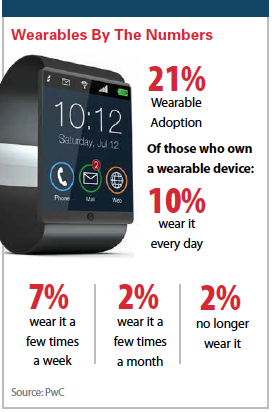 Qualcomm, Otsuka and Proteus Health, Pfizer and 23andMe, Roche and Qualcomm, UCB and MC10.
Qualcomm, Otsuka and Proteus Health, Pfizer and 23andMe, Roche and Qualcomm, UCB and MC10.
“Partnerships are happening and they are going to continue to grow exponentially in the next year or two," Mr. Gwee says. “I also expect to see some acquisitions of small technology companies by pharma."
As pharma starts mapping out a strategy to embrace the concept that wearable technology will become a crucial part of the healthcare system, Mr. Gwee cautions companies against tackling the problem backwards.
“They shouldn’t try to create a wearable strategy first," he says. “First, they need to figure out how wearables fit into what they are doing, and if it doesn’t fit, they shouldn’t try to make it fit. If it makes sense to have a wearable as a companion to the treatment, then companies should partner or merge with a tech company. There is no reason to start from scratch when there are many innovative companies and technologies out there."
Opportunities for pharma companies may be more robust in another few years, says Keith Liu, VP, Klick Labs.
“Opportunities will increase when wearables get to the point of being frictionless and better integrated into the things people always wear — as opposed to slapping something optional on to their wrist — and we should see this start to happen in the next few years," he says.
As the Affordable Care Act pushes providers to improve patient outcomes for increased reimbursement, wearables will become more important as a tool to help patients adhere to treatments and, therefore, improve outcomes. Wearables also provide an opportunity to provide a service beyond the pill for pharma companies in a cluttered competitive marketplace where differentiation is key to success.
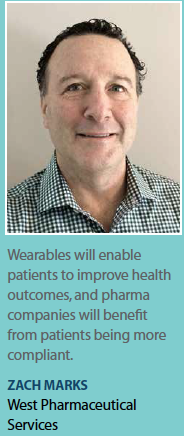 “Web-enabled technology is the next area where life-sciences companies are seeking competitive advantage," Mr. Liu says. “Just like every other industry, pharma is looking to provide a differentiator between product A and product B, and that will evolve beyond just manufacturing a product to also providing the services and data wrapped around it."
“Web-enabled technology is the next area where life-sciences companies are seeking competitive advantage," Mr. Liu says. “Just like every other industry, pharma is looking to provide a differentiator between product A and product B, and that will evolve beyond just manufacturing a product to also providing the services and data wrapped around it."
There are still hurdles to overcome, as wearable technologies aren’t perfect yet, Mr. Liu says. Sometimes the data collected from fitness trackers and other devices are not accurate under certain conditions, and battery life is still an issue for many.
"We are looking at a 36-month timeframe before the technology significantly improves and some of these issues are resolved," Mr. Liu says. “We are in an exploratory phase right now, and pharma companies should continue to experiment and gain insights into how they may add value to their business. However, most pharma companies should probably wait before investing in a wide deployment just yet."
As Millennials become the patients of the future, wearables will become much more mainstream, says Brian Mondry, global head of digital innovation, Kantar Health.
This generation has grown up with sharing as part of their lifestyle, and Millennials may hasten the use of connecting these devices with online communities.
“Health- and wellness-focused online communities will evolve into the platforms where connected consumers will share their data with like-minded people, helping motivate participants toward healthier habits and lifestyles," Mr. Mondry says. “A combination of peer support and friendly competition is where the opportunity lies in maximizing adoption and continual usage of quantified self-technology."
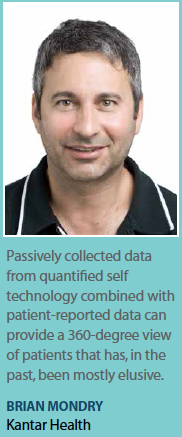 According to PwC, Millennials are 55% more likely to own wearable technology than adults 35 and over. Fifty-one percent of Millennials said they’re likely to purchase a fitness band in the next year (compared with 45% of general consumers) and 40% said they were likely to buy a smartwatch (compared with 35% of the general population).
According to PwC, Millennials are 55% more likely to own wearable technology than adults 35 and over. Fifty-one percent of Millennials said they’re likely to purchase a fitness band in the next year (compared with 45% of general consumers) and 40% said they were likely to buy a smartwatch (compared with 35% of the general population).
According to Mr. Williams, consumers have a high expectancy of what these devices can do for their health, with more than half of those surveyed reporting they expect their life to be longer because of using them.
“The fact that relatively few people currently own these devices but have high expectations of what will happen when they do own them represents a market opportunity," he says. “Winning technology will be all about form factors, functionality, and integration."
Another big hurdle is the cost of wearable products. If the patients who need to be reached for the treatment of type 2 diabetes come from lower income levels, uptake will be extremely low.
“We can’t push out an app for an iWatch if only a handful of people own the device," Mr. Gwee says. “This would be a waste of money."
Beyond the Consumer
There are other stakeholders that will be affected by the emerging trend of wearables. The aggregated data collected can bring value to physicians and providers as well. Insurance companies can collect very useful data and trends on cost of medications and adherence from the data collected from patient wearables.
“There’s a lot of talk about the consumer side, but we should keep in mind that clinicians are starting to embrace these technologies and are using them with the patient," Mr. Williams says. “The asymmetry of information that existed traditionally between the doctor and the patient is collapsing because of these devices. They are allowing the consumer to be more engaged and more responsible for their care 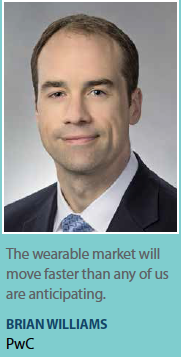 and that will be of tremendous value when we think about the biggest challenges we confront in the United States, which are access to care and adherence to care. Technology will allow us to address both."
and that will be of tremendous value when we think about the biggest challenges we confront in the United States, which are access to care and adherence to care. Technology will allow us to address both."
A report in Reuters confirmed Mr. Williams’ assertion, when it announced that Apple’s HealthKit service is being used at 14 of the 23 top hospitals.
HealthKit acts as a repository for patient-generated health information such as blood pressure, weight, or heart rate. The kits also aim to help physicians monitor patients with such chronic conditions as diabetes and hypertension. (PV)
~~~~~~~~~~~~~~~~~~~~~~~~~~~~~~~~~
Keith Liu / Klick Labs Just like companion diagnostics, someday there will be companion wearables or companion devices to accompany medications.
Shwen Gwee / PharmaFresh.TV Wearables are being adopted by people who are already active, so the challenge is reaching patients who really need them.
Dr. Katrina Firlik / HealthPrize Wearables will enable patients to improve health outcomes, and pharma companies will benefit from patients being more compliant.
Zach Marks / West Pharmaceutical Services Passively collected data from quantified self technology combined with patient-reported data can provide a 360-degree view of patients that has, in the past, been mostly elusive.
Brian Mondry / Kantar Health The wearable market will move faster than any of us are anticipating.
Brian Williams / PwC











